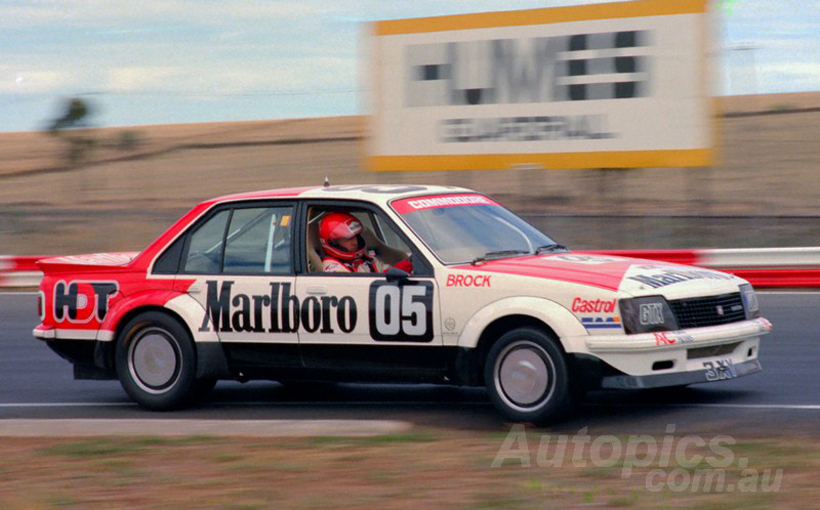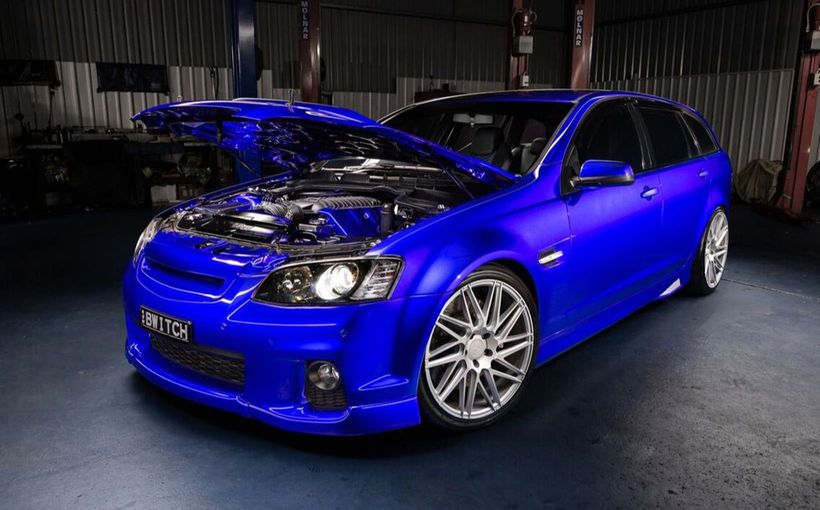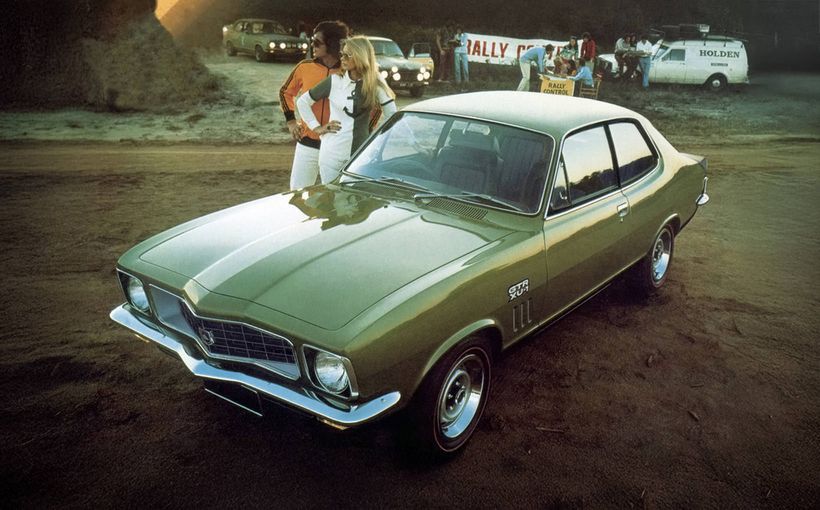VC Commodore: Brock and CAMS ‘Head to Head’

The VC Commodore, foundation stone of Peter Brock’s Holden Dealer Team (HDT) high performance road car division, was the victim of a power struggle in more ways than one due to an ugly political feud with the Confederation of Australian Motor Sport (CAMS) over cylinder heads.
When the HDT special vehicles operation was established in 1980, backed by a consortium of Holden dealers that was also funding the race team, it was envisaged that Brock’s personally modified Commodore road cars would be built in sufficient numbers (500 units) to gain approval or ‘homologation’ of high performance parts for racing.
However, homologation was the sole responsibility of CAMS and in the sport’s governing body Brock, HDT and General Motors-Holden found a formidable opponent. It was a long and increasingly bitter fight which lasted two years, from the first race track appearance of the VC Commodore in 1980 to the debut of its VH SS replacement in 1982.

At the core of the controversy was Brock’s plan to use the big-valve Torana L34-type heads and inlet manifold as fitted to the first of his HDT road cars based on the 308cid (5.0 litre) V8-powered VC Commodore SL/E. It was common practice for car manufacturers to homologate new models and/or new equipment in advance of the minimum number being produced, provided these requirements were met within 12 months from the date of approval.
However, in the case of the VC Commodore, the goodwill previously shown by the governing body was replaced by an unwavering demand that everything be done strictly by the book. As a result, approval to use the big-valve heads was withheld until every one of the 500 VC HDT Commodore road cars had been completed.
With the benefit of hindsight, CAMS’ approach appears to have been as much about resolute rule enforcement as it was a stalling tactic, to allow Ford’s rising star Dick Johnson to get up to speed with the XD Falcon. With the success of its new-for-1980 touring car rules at stake, the last thing CAMS needed was more Torana A9X-style domination by Holden as a new decade dawned. If that was the objective it was certainly achieved, even if the governing body’s objectivity was questionable.

1980: Less Emissions = Less Performance
The mechanical basis of the VC Commodore race car can be traced back to the model’s debut in the ‘new look’ Australian Touring Car Championship in 1980, which saw the LX Toranas and XC Falcons of the 1970s replaced by VB Commodores and XD Falcons with the distinct European flavour of the 1980s.
The new season also heralded a switch to what CAMS referred to as ‘anti-pollution’ engines to present a more environmentally responsible image for the sport as it entered a new decade.
In reality, ‘anti-pollution’ simply meant that XD Falcon runners had to replace the high performance closed-chamber 4V cylinder heads and inlet manifold on the 351cid (5.8 litre) Cleveland V8 with the lower compression, open-chamber 2V heads and manifold.
And Commodore teams had to replace the big-valve Torana L34-type heads and inlet manifold on the 308cid (5.0 litre) V8 with the more restrictive small-valve heads and manifold used on the company’s standard L31 road car version.

Both cars were short of breath at the upper end of the rpm range, but it was more noticeable in the Holden V8 due to its smaller capacity. What had been close to 400bhp in the Torana A9X had been slashed to just over 300bhp in the Commodore.
The Commodore was also heavier, longer and taller than the Torana it replaced, with a longer wheelbase but narrower track. It also introduced new MacPherson Strut front suspension and five-link rear axle architecture, but much of the running gear including the tough Borg Warner T10 four-speed gearbox, Salisbury 10-bolt diff centre etc was familiar to Torana teams.
The Group C race car also sported a fiberglass aero body ‘kit’ penned by Holden stylist Leo Pruneau that comprised a deeper front spoiler, wheel arch flares to house the fat 10-inch wide racing wheels and tyres and a neat three-piece rear spoiler. This ensemble looked like a steroid-fed version of a similar kit seen on Brock’s road cars, creating a strong visual link between the HDT road and race cars.

Although Brock dominated the 1980 ATCC in the VB, with eight pole positions from eight rounds, his third title was secured by the sixth round against thin competition. The second half of the season, when John Harvey joined Brock in a second HDT VB, focused on endurance racing. Two more wins soon followed in August with Brock and Harvey teaming up in ‘05’ to win the CRC 300 at Amaroo Park before finishing 1-2 in opening round of the Australian Championship of Makes (ACM) in Adelaide.
These results only strengthened CAMS resolve, as a more powerful big-valve VC version due to debut at the Sandown 400 in September was going to wipe out what little competition there was for HDT. CAMS dug its heels in, refusing homologation of the big-valve heads on the grounds that not enough of the HDT road cars had been produced.
So even though HDT and other Commodore campaigners had by then either built new VC Commodores or cosmetically updated their VBs, they were stuck with the small-valve heads and no rear spoiler for the time being.

According to David Hassall’s authorised biography Brocky the Holden star was understandably less than impressed with the governing body’s treatment:
“This was a great disappointment for Peter because he naturally wanted to promote the HDT Commodore road car through his racing. Peter was also offended by the inference that he was merely a hot-rodder, producing one-off specials. The truth of the matter was that he and GMH were working closely and had done an enormous amount of testing - at great expense – to satisfy all the Australian Design Rules pertaining to exhaust emissions and the like.”
Even so, Brock’s performances in the prestigious Sandown 400 and Bathurst 1000 races appeared to vindicate CAMS’ stance on the issue. At Sandown both of the HDT cars were updated with the latest VC ‘egg-crate’ grilles but nothing else really changed. Brock led home a Commodore 1-2-3 finishing a lap ahead of Garry Rogers in Fred Geissler’s VC and HDT ‘team mate’ Allan Moffat in a crowd-pleasing one-off guest drive in Harvey’s car.

Just in time for the Bathurst 1000 on October 5, CAMS partly relented on its Brock blockade with homologation of the Commodore’s three-piece rear spoiler which Brock and co-driver Jim Richards used to good effect on the Mountain.
After colliding with a slower car in the early running and being lapped by runaway race leader Dick Johnson, the Falcon driver’s early demise caused by a collision with an infamous rock allowed Brock and Richards to claw back a one-lap deficit to win the race against considerable odds.
Today it’s interesting to note that the rear spoiler fitted to the HDT road car was approved for use on the race car just in time for Bathurst, even though the big-valve heads were not on the basis that not enough road cars had been built in time. Huh?

Knowing the chaos that was CAMS in 1980, there could be any number of reasons for this decision, although we suspect it was something to do with different ‘minimum number’ requirements being applied to different parts on the cars for approval. Fact is, Group C homologation was always very ‘wink, wink, nudge, nudge’, which resulted in numerous rulings that today appear to lack any logic or due process.
HDT did not make the long trek north to Surfers Paradise for the final 300km ACM round, which still saw privately-entered Commodores led by Charlie O’Brien claim another 1-2-3 result.

1981: Brock and CAMS Still Banging ‘Heads’
The dispute between HDT and CAMS dragged on throughout 1981, with Brock continuing to lobby for the big-valve heads in the face of Dick Johnson’s more powerful 5.8 litre XD Falcon in the ATCC.
Johnson was backing CAMS in arguing against any power increase for the Holdens, pointing out how closely matched the Falcon and Commodore had become. While they were certainly close on the track, it should be pointed out that the only time Brock actually overtook Johnson was on rare occasions when the Queenslander spun off.
If not for those errors, Johnson would have sealed his first ATCC title earlier in the season without having to face Brock in a gripping winner-take-all final round on Johnson’s home turf at Lakeside Raceway. It was a desperately close struggle which Johnson led the whole way, despite a broken sway bar and immense pressure from Brock.

In Johnson’s absence Brock won the first round of the Australian Endurance Championship (AEC) in Adelaide before teaming up again with John Harvey to win the non-championship CRC 300 at Amaroo Park, after Johnson suffered tyre troubles on the tight Sydney track.
Then in HDT’s absence Johnson won the second AEC round at Oran Park before Brock hit back in round three with his seventh consecutive Sandown 400 win, but only after pole sitter and early leader Johnson suffered shock absorber problems which led to costly spins.
Ford’s new hero then won his first Bathurst 1000 after Brock snapped an axle while leading the early running. Johnson’s victory was achieved in controversial circumstances, though, when the race had to be red-flagged after 120 of 163 laps due to a fearful multi-car wreck on the top of the Mountain that blocked the track.

Brock and HDT looked like they’d finished a difficult season on a high with victory in the final AEC round at Surfers Paradise, only to be robbed of the win post-race due a 60-second penalty being imposed for push-starting the car after a pit stop!
Throughout the season CAMS had refused to budge on the big-valve heads until it was satisfied that the required number of HDT road cars had been produced. In fact, official recognition of the VC ‘Brock’ Commodore was not granted until December 1, 1981 about three months after production of that model had ceased, which left Brock disillusioned with his treatment.
“For the umpteenth time, I’ll remind everyone that no manufacturer has ever had to do that before,” he told Australian Motor Racing.

1982: The Final Showdown
Brock and his fellow VC Commodore racers were finally granted approval to run the big-valve heads from the start of the 1982 season. However, their collective sigh of relief was only brief as another ugly legal battle erupted that ended up in the Supreme Court.
What triggered the stoush was a new set of minimum vehicle weights introduced by CAMS to ensure that any engine used in a touring car was installed in the same body as the road car version. For HDT this meant carrying a lot more weight, from about 1250kg to a new 1327kg minimum, as its VC road car was based on Holden’s top-shelf SL/E model loaded with luxury equipment.
A breakdown in communication between CAMS and Holden teams over how these new weight rules would be applied, though, led to farcical scenes in the second round of the 1982 ATCC at Melbourne’s Calder Park.
HDT and other Commodore teams running the new big-valve ‘HDT Special’ arrived at Calder for the start of practice with lead ballast placed in their cars to meet the new minimum weight, rather than the ‘luxury equipment’ as specified by CAMS.

After lengthy arguments between the practice sessions, it was decided that competitors could temporarily secure the various luxury items in the cars (as close as possible to their road car locations) for the Calder round before being properly installed before the next round in Tasmania.
Holden rivals at Calder must have got a good laugh from seeing Brock and other Commodore drivers lining up on the grid with various luxury road car items strapped and taped inside their engine bays and passenger compartments!
Brock duly won the 50-lap race but his joy was again to be short-lived when scrutineers ruled that the inlet manifold on his winning car and a couple of private entries had received a metal finishing treatment that did not comply with the rules.

“CAMS just did not want us to race that car,” Brock reflected in Brocky. “They told us there would be trouble if we ran it and we knew that before we started. So we covered ourselves and tried to find anything on the car they could possibly get us on. We couldn’t think of anything. Anyway, sure enough they tried to get us at Calder, which was the first time I raced it.
“That was not the end of it though. At the end of the race, the scrutineers waved all the other competitors through before stripping down the leading Commodores.
“The first thing they tried to get us on was that the inlet manifold was too small. We told them we couldn’t help that because that’s how GMH builds them, but then they said, ‘Hang on, forget that, the finish of the manifold is too good – it’s been shot-peened’. I told them that we hadn’t; it was rubbish.
“We found out later that it had, in fact, been shot-peened by GMH, because that’s how they’re made. We’d just picked the best-looking ones we could, which is our prerogative. We put a different one on and won the very next race, but they didn’t want to talk with us – they were going to nail us and that was that.”
Brock lost his points from the meeting and was handed an immediate three-month suspension. The multiple Bathurst champ was so incensed by what he saw as a gross injustice that he boldly launched legal action against CAMS in the Victorian Supreme Court.

With Brock racing under appeal from then on, interest in the 1982 ATCC quickly fell away as no one knew if the championship-winning points he accumulated from several wins were going to stick due to the ongoing dispute with CAMS. The conflict was finally settled out of court, with Brock forfeiting his claim to the 1982 ATCC which was won by back-to-back champion Dick Johnson in his XD Falcon.
The ill-feeling created by the whole painful saga over the VC Commodore and its big-valve heads was something that Brock/HDT and General Motors-Holden wanted to avoid in future, which led to development of the VH SS Commodore which enjoyed a painless homologation and went on to win two Bathurst 1000s.
Even so, the VC Commodore was still a successful race car having claimed numerous major wins including a Bathurst 1000, two Sandown 400s and coming within two-tenths of a second of winning an ATCC. All that, despite carrying more than its fair share of political ballast from start to finish.









